

Fundamentos sobre certificados digitales (III): Cadena de confianza. Siguiendo en la línea de los anteriores posts (Fundamentos sobre certificados digitales, primera y segunda parte), continuamos hablando de firma y certificación digital.
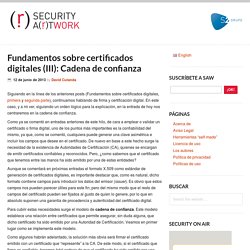
En este caso, y a mi ver, siguiendo un orden lógico para la explicación, en la entrada de hoy nos centraremos en la cadena de confianza. Como ya se comentó en entradas anteriores de este hilo, de cara a emplear o validar un certificado o firma digital, uno de los puntos más importantes es la confiabilidad del mismo, ya que, como se comentó, cualquiera puede generar una clave asimétrica e incluir los campos que desee en el certificado. De nuevo en base a este hecho surge la necesidad de la existencia de Autoridades de Certificación (CA), quienes se encargan de emitir certificados confiables y reconocidos. Pero, ¿como sabemos que el certificado que tenemos entre las manos ha sido emitido por una de estas entidades? Insurance: The Basics. DDoS Attack Glossary. DDoS Attack Glossary Developed by Robert "RSnake" Hansen, Slowloris is DDoS attack software that enables a single computer to take down a web server.
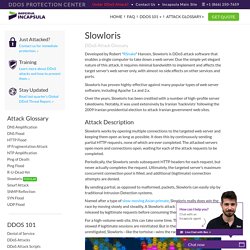
Due the simple yet elegant nature of this attack, it requires minimal bandwidth to implement and affects the target server’s web server only, with almost no side effects on other services and ports. Slowloris has proven highly-effective against many popular types of web server software, including Apache 1.x and 2.x. Over the years, Slowloris has been credited with a number of high-profile server takedowns. Notably, it was used extensively by Iranian ‘hackivists’ following the 2009 Iranian presidential election to attack Iranian government web sites.
Attack Description Slowloris works by opening multiple connections to the targeted web server and keeping them open as long as possible. Periodically, the Slowloris sends subsequent HTTP headers for each request, but never actually completes the request. Methods of Mitigation. Database per service. Microservices.io is brought to you by Chris Richardson.
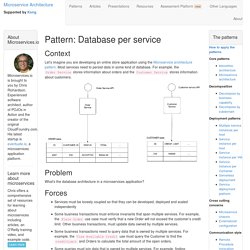
Experienced software architect, author of POJOs in Action and the creator of the original CloudFoundry.com. His latest startup is eventuate.io, a microservices application platform. Learn more about microservices Chris offers a comprehensive set of resources for learning about microservices including articles, an O'Reilly training video, and example code. Learn more Microservices consulting and training Chris offers a comprehensive consulting services, workshops and hands on training classes to help you use microservices effectively. Example microservices applications Want to see an example? Get the book: Microservice patterns. Creately - Online Diagram Editor - Try it Free. Encoding vs. Encryption vs. Hashing.
Encoding is often confused with encryption and hashing.
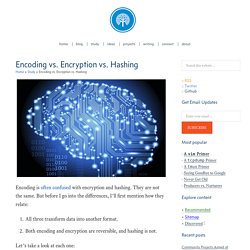
They are not the same. But before I go into the differences, I’ll first mention how they relate: All three transform data into another format. Both encoding and encryption are reversible, and hashing is not. Let’s take a look at each one: Encoding The purpose of encoding is to transform data so that it can be properly (and safely) consumed by a different type of system, e.g. binary data being sent over email, or viewing special characters on a web page. Encoding transforms data into another format using a scheme that is publicly available so that it can easily be reversed. Examples: ASCII, Unicode, URL Encoding, Base64 Encryption The purpose of encryption is to transform data in order to keep it secret from others, e.g. sending someone a secret letter that only they should be able to read, or securely sending a password over the Internet.
Hashing Examples: SHA-3, MD5 (Now obsolete), etc.
Personal. Quickstart Guide. Available languages | en | ja | Let’s get started with Fluentd!
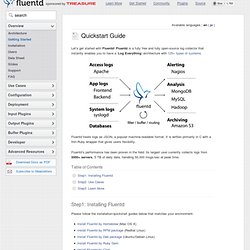
Fluentd is a fully free and fully open-source log collector that instantly enables you to have a ‘Log Everything’ architecture with 125+ types of systems. Fluentd treats logs as JSON, a popular machine-readable format. It is written primarily in C with a thin-Ruby wrapper that gives users flexibility. Fluentd’s performance has been proven in the field: its largest user currently collects logs from 5000+ servers, 5 TB of daily data, handling 50,000 msgs/sec at peak time. Table of Contents Step1: Installing Fluentd Please follow the installation/quickstart guides below that matches your environment. Step2: Use Cases The articles shown below cover the typical use cases of Fluentd. Step3: Learn More The articles shown below will provide detailed information for you to learn more about Fluentd.
ITIL. Lenguaje de programación multiparadigma. Un lenguaje de programación multiparadigma es el que soporta más de un paradigma de programación.

Según lo describe Bjarne Stroustrup, permiten crear “programas usando más de un estilo de programación”. El objetivo en el diseño de estos lenguajes es permitir a los programadores utilizar el mejor paradigma para cada trabajo, admitiendo que ninguno resuelve todos los problemas de la forma más fácil y eficiente posible. Paradigmas de programación[editar] Véase también[editar]